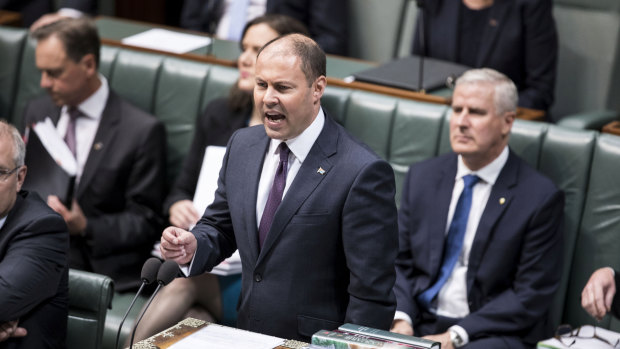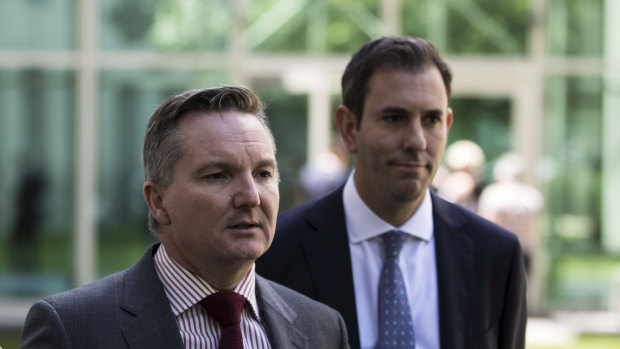This was published 6 years ago
Fears for economy as consumers hit brakes on spending
By Eryk Bagshaw
Australian consumers have hit the brakes on spending, savings rates have fallen to decade lows and wages have flatlined sparking predictions of a broader slowdown as the Coalition frames its re-election campaign around a strong economy.
Suprisingly weak official data released on Wednesday showed the economy grew at half the rate tipped by experts prompting renewed speculation the Reserve Bank's next move will be to cut rates.

Treasurer Josh Frydenberg.Credit: Dominic Lorrimer
Underlining the threat of a spending strike in the lead up to Christmas, the value of unsold goods sitting in retailer storerooms surged by $800 million over the quarter, the biggest such jump in three years.
The disappointing 2.8 per cent overall growth rate for the year to September sets up a tax cut race in the new year, with both parties pledging to put money back into workers wallets to drive them back to the shops.
Treasurer Josh Frydenberg denied the figures were disappointing, adding the decade-low-savings ratio showed Australians had confidence in the economy and were taking advantage of historically low-interest rates.
"The Australian economy is strong and is in a good shape, we are in our 27th year of consecutive economic growth," he said.
"Business conditions and consumer confidence remain strong, our AAA credit rating has been re-affirmed and next year we will deliver the first budget surplus in over a decade."
Despite the optimism, futures markets are for the first time now tipping an interest rate cut in 2019, signalling investors did not share the government's outlook.
AMP chief economist Shane Oliver said the sluggish result meant the odds of a surprise cut in the second half of 2019 was becoming more likely, despite the RBA maintaining the next move in rates was expected to be up.
Analysts had predicted the economy would grow by about 0.6 per cent for the three months to the end of September or a 3.3 per cent result for the year.
The disappointing result saw the Australian dollar fall sharply below US73¢ on the release of the data.
It came after the market endured a separate economic battering in the morning, falling to a 23-month low on the back of global scepticism over a trade truce between Chinese President Xi Jinping and US President Donald Trump.
Shadow treasurer Chris Bowen seized on the accounts claiming they were a "very bad set of numbers for the Abbott-Turnbull-Morrison government".
"I’m not going to pretend that a growth figure with a two in front of it in this benign economic environment is cause for celebration," he said. "It is not, the government should be very disappointed."
The Coalition is considering accelerating tax cuts worth $10 billion a year as it begins preparations for the April budget. Labor says its tax cuts will deliver greater relief to low-income earners.
"What the Liberal Party wants you to believe is if they shower largesse on the top end of town it will miraculously trickle down," said Labor's finance spokesman Jim Chalmers.

Shadow treasurer Chris Bowen and Shadow Finance spokesman Jim Chalmers. Credit: Dominic Lorrimer
"We think the priority for tax relief should be people on low-and middle-incomes. They're more likely to spend; they're more likely to get that consumption going."
Billions of dollars in public infrastructure spending helped push up Wednesday's result, while a sudden 7.5 per cent fall in mining investment hampered further gains.
TD Securities economist Annette Beacher said the result was underwhelming but not disastrous.
"After a very strong second quarter [3.4 per cent year on year], we see this as a pause rather than a retrenchment in spending," she said.
The biggest concern for policymakers is the softer than expected result for household consumption, which grew just 0.3 per cent.
The wages-fuelled measure is responsible for up to 60 per cent of all economic growth. The metric has been stuck at historic lows, despite the total wages bill growing strongly on the back of an immigration driven jobs boom.
ANZ economist Felicity Emmett said the persistent weakness was surprising.
"The GDP measure of non-farm average wages rose just 1.2 per cent, and [is] slowing," she said.
"Once again, this is a disappointing outcome and suggests that the tighter labour market is putting very little pressure on labour costs."
Wage growth also had an impact on two other key indicators, household savings and inventories, with the savings ratio declining to 2.4 per cent in the September quarter.
"This is the lowest saving rate since December 2007," said Australian Bureau of Statistics chief economist Bruce Hockman.
The low level of consumption has meant shops have been unable to move millions of dollars of stock, with the value of retail inventories growing by $844 million and subtracting as much as 0.3 per cent from GDP.
Holidaying couple on Bourke Street Mall Jaye Ryan, 36, and husband Judah, 42, said they were "absolutely" budget conscious.
"Especially with the kids, things are getting pretty expensive," said Ms Ryan, who is currently on maternity leave from working as a horticulturist.
"We buy the big ticket items like dishwashers and things like that but kids toys and clothes have not been a priority."
With Charlotte Grieve